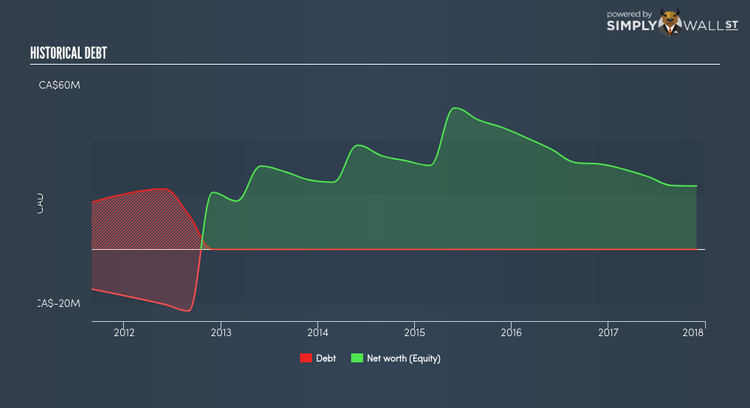What Is theScore Inc’s (CVE:SCR) Financial Position?

The direct benefit for theScore Inc (TSXV:SCR), which sports a zero-debt capital structure, to include debt in its capital structure is the reduced cost of capital. However, the trade-off is SCR will have to adhere to stricter debt covenants and have less financial flexibility. While zero-debt makes the due diligence for potential investors less nerve-racking, it poses a new question: how should they assess the financial strength of such companies? I will take you through a few basic checks to assess the financial health of companies with no debt. Check out our latest analysis for theScore
Is SCR growing fast enough to value financial flexibility over lower cost of capital?
Debt capital generally has lower cost of capital compared to equity funding. However, the trade-off is debtholders’ higher claim on company assets in the event of liquidation and stringent obligations around capital management. SCR’s absence of debt on its balance sheet may be due to lack of access to cheaper capital, or it may simply believe low cost is not worth sacrificing financial flexibility. However, choosing flexibility over capital returns is logical only if it’s a high-growth company. A revenue growth in the teens is not considered high-growth. SCR’s revenue growth of 10.17% falls into this range. While its low growth hardly justifies opting for zero-debt, the company may have high growth projects in the pipeline to justify the trade-off.
Does SCR’s liquid assets cover its short-term commitments?
Since theScore doesn’t have any debt on its balance sheet, it doesn’t have any solvency issues, which is a term used to describe the company’s ability to meet its long-term obligations. However, another measure of financial health is its short-term obligations, which is known as liquidity. These include payments to suppliers, employees and other stakeholders. With current liabilities at CA$2.80M, it appears that the company has maintained a safe level of current assets to meet its obligations, with the current ratio last standing at 6.04x. However, a ratio greater than 3x may be considered as too high, as SCR could be holding too much capital in a low-return investment environment.
Next Steps:
Since SCR is a low-growth stock in terms of its revenues, not taking advantage of lower cost debt may not be the best strategy. Shareholders should understand why the company isn’t opting for cheaper cost of capital to fund future growth, and whether the company needs financial flexibility at this point in time. I admit this is a fairly basic analysis for SCR’s financial health. Other important fundamentals need to be considered alongside. You should continue to research theScore to get a better picture of the stock by looking at:
1. Future Outlook: What are well-informed industry analysts predicting for SCR’s future growth? Take a look at our free research report of analyst consensus for SCR’s outlook.
2. Valuation: What is SCR worth today? Is the stock undervalued, even when its growth outlook is factored into its intrinsic value? The intrinsic value infographic in our free research report helps visualize whether SCR is currently mispriced by the market.
3. Other High-Performing Stocks: Are there other stocks that provide better prospects with proven track records? Explore our free list of these great stocks here.
To help readers see pass the short term volatility of the financial market, we aim to bring you a long-term focused research analysis purely driven by fundamental data. Note that our analysis does not factor in the latest price sensitive company announcements.
The author is an independent contributor and at the time of publication had no position in the stocks mentioned.

